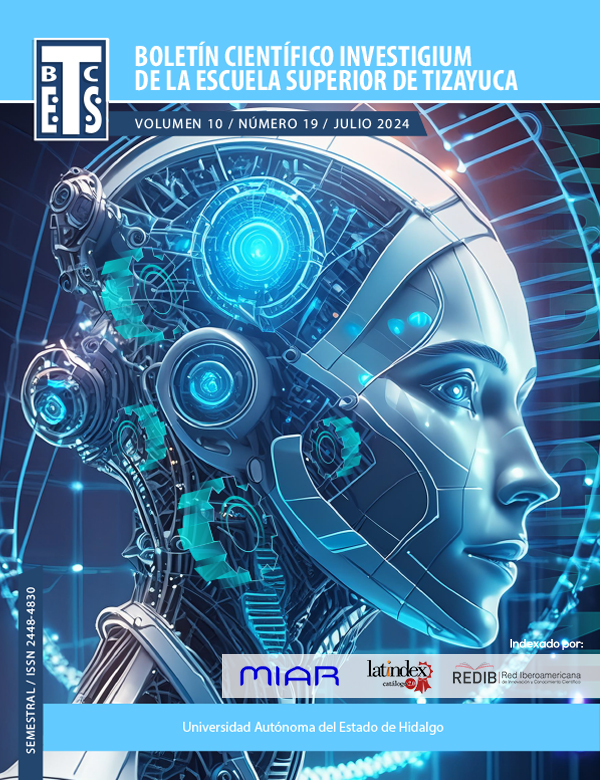Estimación de escenarios de llegadas de visitantes a Pachuca principal destino del Estado de Hidalgo, México
DOI:
https://doi.org/10.29057/est.v10i19.12609Palabras clave:
Turismo, auto-regresión, medias móviles, escenariosResumen
El turismo en México es uno de los aspectos más relevantes que diversifican y potencializan la economía nacional y regional. Dado el creciente interés por gestionar información de los destinos turísticos a raíz de la pandemia de covid-19 en este trabajo se propone la identificación de parámetros en el mayor destino del estado de Hidalgo para entablar escenarios de pronóstico de la llegada de visitantes. Los resultados muestran la mejor combinación ARMA (8,0,8) con sus respectivos parámetros optimización, lo que sugiere que los datos más probables oscilaran alrededor de 30,000 visitantes al mes con un límite inferior de 10,000 visitantes y superior de 50,000. Concluimos que el modelo ARMA constituye una herramienta de análisis adecuada para estimar el pronóstico de datos el proceder turístico del destino analizado.
Descargas
Citas
Benavides Vindas, S. (2020). El aporte del turismo a la economía costarricense: más de una década después. Economía y Sociedad, 25(57), 1-29. https://doi.org/10.15359/eys.25-57.1
Benseny, M. G. (2007). El turismo en México. apreciaciones sobre el turismo en espacio litoral. Aportes y Transferencias, 11 (2) 13-34.
Beynon-Davies, P. (2018). Sistemas de bases de datos. Reverte.
Bi, J.-W., Li, H., & Fan, Z.-P. (2021). Tourism demand forecasting with time series imaging: A deep learning model. Annals of Tourism Research, 90, 103255. https://doi.org/10.1016/j.annals.2021.103255
Box, G. E. P., & Jenkins, G. M. (1976). Time Series Analysis: Forecasting and Control. Holden-Day.
Box, G. E. P., Jenkins, G. M., Reinsel, G. C., & Ljung, G. M. (2015). Time Series Analysis.
Cerón Monroy, H., Silva Urrutia, J. E., Ceron Monroy, H., & Silva Urrutia, J. E. (2017). La relación entre un proxi de la dinámica de la inseguridad pública y el turismo internacional a México: un análisis econométrico. El periplo sustentable, 33, 105-131.
Chang, Y.-W., & Liao, M.-Y. (2010). A Seasonal ARIMA Model of Tourism Forecasting: The Case of Taiwan. Asia Pacific Journal of Tourism Research, 15(2), 215-221. https://doi.org/10.1080/10941661003630001
Claveria, O., & Torra, S. (2014). Forecasting tourism demand to Catalonia: Neural networks vs. time series models. Economic Modelling, 36, 220-228. https://doi.org/10.1016/j.econmod.2013.09.024
Conde Gaxiola, N. (2013). Análisis de la llegada de turistas internacionales a México. Investigación administrativa, 42(111), 20-34.
Contreras Juárez, A., Atziry Zuñiga, C., Martínez Flores, J. L., & Sánchez Partida, D. (2016). Análisis de series de tiempo en el pronóstico de la demanda de almacenamiento de productos perecederos. Estudios Gerenciales, 32(141), 387-396. https://doi.org/10.1016/j.estger.2016.11.002
Dogan, E., & Zhang, X. (2023). A nonparametric panel data model for examining the contribution of tourism to economic growth. Economic Modelling, 128, 106487. https://doi.org/10.1016/j.econmod.2023.106487
Dong, Y., Xiao, L., Wang, J., & Wang, J. (2023). A time series attention mechanism based model for tourism demand forecasting. Information Sciences, 628, 269-290. https://doi.org/10.1016/j.ins.2023.01.095
Dong, Y., Zhou, B., Yang, G., Hou, F., Hu, Z., & Ma, S. (2023). A novel model for tourism demand forecasting with spatial–temporal feature enhancement and image-driven method. Neurocomputing, 556, 126663. https://doi.org/10.1016/j.neucom.2023.126663
García, Á. R. S., Peñate, M. U., Herrera, R. A., Gómez, Á. A. H., Estrella, G. M. E., & Peñate, A. V. (2022). Modelación econométrica y estocástica en los pronósticos de ventas de jengibre en Ecuador. Ingeniería Investigación y Desarrollo, 22(1), 25-43. https://doi.org/10.19053/1900771X.v22.n1.2022.14453
Ibáñez, L. H. (2015). Administración de Sistemas Gestores de Base de Datos. 2a Edición. Grupo Editorial RA-MA.
Jalil, A., & Rao, N. H. (2019). Chapter 8 - Time Series Analysis (Stationarity, Cointegration, and Causality). En B. Özcan & I. Öztürk (Eds.), Environmental Kuznets Curve (EKC) (pp. 85-99). Academic Press. https://doi.org/10.1016/B978-0-12-816797-7.00008-4
Liu Sun, X., Covarrubias López, J. G., Liu Sun, X., & Covarrubias López, J. G. (2023). Convergencia dinámica de series temporales y su inconsistencia con la estacionariedad en análisis económicos. Análisis económico, 38(97), 5-26. https://doi.org/10.24275/uam/azc/dcsh/ae/2022v38n97/liu
Meza, E. C. J. (2016). Un enfoque a la importancia del turismo. Turismo y Patrimonio, 10, 10. https://doi.org/10.24265/turpatrim.2016.n10.09
Olcina Cantos, J. (2012). Turismo y cambio climático: una actividad vulnerable que debe adaptarse. Investigaciones Turísticas, 4, 1. https://doi.org/10.14198/INTURI2012.4.01
Pérez-Ramírez, C. A., & Antolín-Espinosa, D. I. (2016). Programa pueblos mágicos y desarrollo local: actores, dimensiones y perspectivas en El Oro, México. Estudios sociales (Hermosillo, Son.), 25(47), 217-242.
Petrevska, B. (2017). Predicting tourism demand by A.R.I.M.A. models. Economic Research-Ekonomska Istraživanja, 30(1), 939-950. https://doi.org/10.1080/1331677X.2017.1314822
Planas, M., Rodríguez, T., & Lecha, M. (2004). La importancia de los datos. Nutrición Hospitalaria, 19(1), 11-13.
Rodríguez, R. M. A. S., Pulido-Fernández, J. I., & Herrera, I. M. R. (2017). El producto turístico en los Pueblos Mágicos de México. Un análisis crítico de sus componentes. Revista de Estudios Regionales, 108, 125-163.
Sectur. (2001). Pueblos Mágicos. Reglas de Operación. Secretaria de Turismo Federal.
Sectur. (2020). Pueblos Mágicos de México. gob.mx. http://www.gob.mx/sectur/articulos/pueblos-magicos-206528
Sectur. (2023a). Estrategia Nacional De Turismo 2019-2024 Tendrá Un Sentido Democrático: Miguel Torruco. gob.mx. http://www.gob.mx/sectur/prensa/estrategia-nacional-de-turismo-2019-2024-tendra-un-sentido-democratico-miguel-torruco
Sectur. (2023b). Datatur3 - RankingOMT. https://www.datatur.sectur.gob.mx/SitePages/RankingOMT.aspx
Sotomayor, D. A. C., Carlos, F. B. S. M., Sotomayor, D. A. C., & Carlos, F. B. S. M. (2021). Aplicación del método autorregresivo integrado de medias móviles para el análisis de series de casos de covid-19 en Perú. Revista de la Facultad de Medicina Humana, 21(1), 65-74. https://doi.org/10.25176/rfmh.v21i1.3307
Tudela-Mamani, J. W., Cahui-Cahui, E., Aliaga-Melo, G., Tudela-Mamani, J. W., Cahui-Cahui, E., & Aliaga-Melo, G. (2022). Impacto del COVID-19 en la demanda de turismo internacional del Perú. Una aplicación de la metodología Box-Jenkins. Revista de Investigaciones Altoandinas, 24(1), 27-36. https://doi.org/10.18271/ria.2022.317
UNWTO. (2023). Nuevos datos apuntan a una recuperación total del turismo con un vigoroso arranque en 2023. https://www.unwto.org/es/news/nuevos-datos-apuntan-a-una-recuperacion-total-del-turismo-con-un-vigoroso-arranque-en-2023
Vukovic, D. B., Ingenito, S., & Maiti, M. (2023). Time series momentum: Evidence from the European equity market. Heliyon, 9(1), e12989. https://doi.org/10.1016/j.heliyon.2023.e12989
Xian, S., Feng, M., & Cheng, Y. (2023). Incremental nonlinear trend fuzzy granulation for carbon trading time series forecast. Applied Energy, 352, 121977. https://doi.org/10.1016/j.apenergy.2023.121977
Xuanming, P., Dossou, T. A. M., Dossou, K. P., & Alinsato, A. S. (2023). The impact of tourism development on social welfare in Africa: quantile regression analysis. Current Issues in Tourism, 0(0), 1-14. https://doi.org/10.1080/13683500.2023.2214351


















